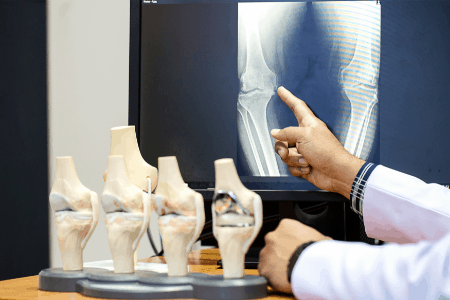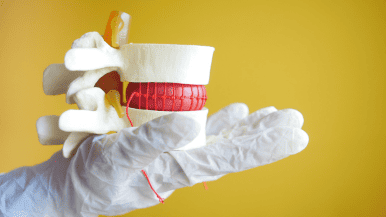 Why would I need a knee replacement?
Why would I need a knee replacement?- What is knee replacement?
- What’s it like to recover from a knee replacement?
- How long does a knee replacement last?
Each year, around 600,00 people in the United States undergo knee replacement surgery, but how long does it take to recover from a knee replacement?
These surgeries are usually conducted when the knee is so damaged that you end up in pain and with difficulties walking, sitting, or conducting other normal daily activities. It’s a very effective surgical procedure; 90% of patients undergoing knee replacement experience a significant reduction in the pain they experience each day.
Why Would I Need a Knee Replacement?
Knees that are damaged by arthritis or injury often fail to function properly. The purpose of the knee, which is the body’s largest joint, is ambulation. Without a properly functioning knee joint, you will have trouble doing the simplest of tasks, such as walking from your bed to the restroom or sitting down and getting up from your couch. When your knees continue to worsen you may even have trouble sleeping because of pain in your knees.
Unless the knee has been injured in an accident of some sort, this is a gradual process where the joint gradually wears out over time. Your doctor may try a variety of treatments, from lifestyle changes, such as giving up running, to medications to help with the pain. For a time, you may try walking with supportive devices such as a cane or wearing leg braces. Eventually, though, when your efforts to manage the pain no longer work, it’s time to consider knee replacement.
What Is a Knee Replacement?
 Knee replacement is also known as total knee replacement or total knee arthroplasty. This surgery involves the surgical removal of the human knee joint, then replacement with a new prosthetic knee made of plastics and metals. The prosthetic device then functions in the same way as the original joint.
Knee replacement is also known as total knee replacement or total knee arthroplasty. This surgery involves the surgical removal of the human knee joint, then replacement with a new prosthetic knee made of plastics and metals. The prosthetic device then functions in the same way as the original joint.
As a surgery, knee replacement is one of the most common and safe medical procedures in the United States. The first knee replacement was performed in 1968. Since then, the procedure doctors use to replace your knee is much more efficient, less invasive, and more effective overall.
During the knee arthroplasty procedure, your doctor will remove the patella (knee cap) and clean up the end of the femur (thigh bone) and the tibia (lower shin bone). The end surface of the tibia is replaced with metal and a plastic liner is inserted between the tibia and the femur to reduce wear. Then the patella is resurfaced and the surgeon will test the knee to ensure a smooth gliding surgery. The procedure will last about two hours, typically.
What’s It Like to Recover From a Knee Replacement?
As soon as you wake up from knee replacement surgery, your rehabilitation can begin. Patients are encouraged to begin walking with a walker, crutches, or a cane on the same day that their surgery occurred. Within three to six weeks after total knee arthroplasty, you will gradually resume many of your normal activities, but not all until you are released from a doctor’s care.
Your physical therapist will help you learn to safely use the new joint and will go over all of the aftercare necessary to recover successfully from the surgery. They will help you use a continuous passive motion (CPM) machine, to gently move the joint to speed the healing process. You’ll also learn to change your bandage, and practice how to get to and from the bathroom. Your physical therapist will also teach you the exercises necessary to help you regain the full range of motion in your new joint.
Typically, you will return home as long as you have a support system in place to help care for you during the rehabilitation process.
You will have some pain, bruising, and swelling after the surgery. Your doctor will likely prescribe some pain medications that are stepped down to over-the-counter anti-inflammatories and pain relievers over time. Your orthopaedic surgeon may have you wear a support hose or compression boots to reduce the risk of blood clots and cut down on leg swelling.
Your goal during the rehabilitation process is to follow the instructions of your healthcare team and get plenty of rest. As you begin to recover from the surgery, your activity will gradually increase under the careful supervision of your healthcare team. Some of the exercises you may begin during this time include:
- Slow, careful stair climbing
- Using the CPM machine
- Achieving full knee extension and knee flexion (bending)
- Standing up and slowly walking
 During the first three weeks, you will begin to see a physical therapist who will work with you on specific exercises to strengthen the knee and regain your mobility. Physical therapy is customized, but typically walking and balance exercises, strengthening, electrical stimulation, and other pain-relieving and rehabilitative procedures.
During the first three weeks, you will begin to see a physical therapist who will work with you on specific exercises to strengthen the knee and regain your mobility. Physical therapy is customized, but typically walking and balance exercises, strengthening, electrical stimulation, and other pain-relieving and rehabilitative procedures.
Wound care will be an important part of the first few weeks after knee replacement surgery. You will have staples or stitches along the wound, which will be removed several weeks post-surgery. Your caregiver will help with dressing changes and monitoring the incision for any signs of infection.
After the first month, your recovery may look something like this:
- Weeks 4-6 – You will begin to return to daily activities such as driving and household chores
- Weeks 7-12 – You can begin returning to low-impact activities such as the stationary bicycle or swimming
- Weeks 12 and beyond – If your surgeon agrees, you can start to return to a little more intense activity, such as off-road hiking
The entire process of rehabilitating the knee can take up to six months or even a year, depending upon the types of activities you would like to return to. At each stage in the process, you will grow a little stronger and more stable on the joint until you return to normal but without the crippling pain you experienced before the surgery.
How Long Does a Knee Replacement Last?
According to the data, about 90% of knee replacements last a minimum of 15 years, but many are still doing well at the 20-year mark. You can extend the life of your replacement knee by staying active and keeping your weight down. It’s a good idea to avoid high-impact exercise like jogging, however.
Advanced Orthopaedic Centers offer state-of-the-art care for patients to improve the quality of their lives. We offer a variety of procedures, including total knee replacement, to help our patients return to a pain-free life. Call on us to discuss your options.



